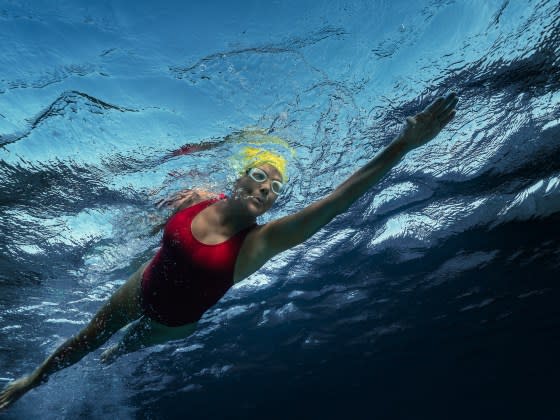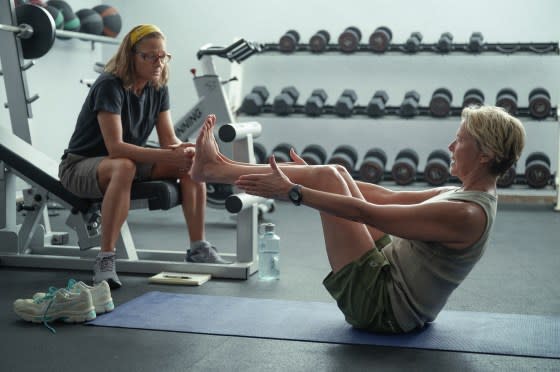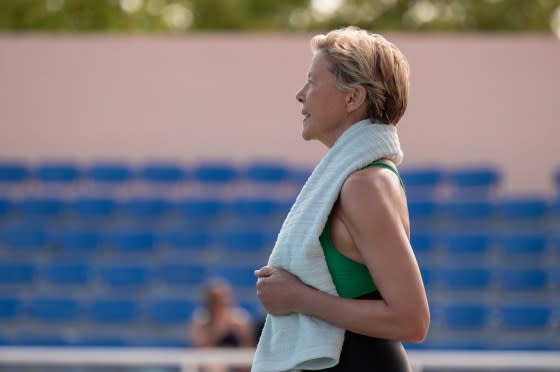The Deeper Story Behind Netflix's Nyad
- Oops!Something went wrong.Please try again later.
- Oops!Something went wrong.Please try again later.
Nyad tells the story of Diana Nyad, a marathon swimmer who broke records and achieved a number of firsts in the sport. At the age of 60, she decided to complete the feat she wasn’t able to when she was 28—swim the more than 100 miles from Cuba to Florida without the aid of a shark cage, powered only by her stubborn will and swimming prowess.
The Cuba to Florida crossing, through the Florida Straits, has long held a mystique for marathon swimmers for its challenging conditions. Unlike the English Channel, where the water temperature averages about 62F, the Florida waters are warmer, in the 80F range, but that also means they are home to dangerous marine life—most notably sharks and box jellyfish, whose stings can transfer enough toxin to paralyze and even kill a person. The Gulf Stream also makes the currents quixotic, so if a swimmer isn't guided by a seasoned navigator, she could find herself pushed off course into the Gulf of Mexico or toward the Bahamas. A few people had attempted it, but only with shark cages, including Nyad during that first try in her 20s.
The film, which opened in limited theaters in October and releases on Netflix on Nov. 3, picks up on Nyad's 60th birthday, when, after decades away from the sport, during which she worked as a sports commentator for ABC's Wide World of Sports, she faces her mortality and decides to prove that she can make the crossing without a cage. “It’s not like I was fixated on doing that swim all those years, but I guess somehow, I was, and that I always did have Cuba in the back of my brain,” she tells TIME.
Directed by Jimmy Chin and Elizabeth Chai Vasarhelyi in their first narrative project after earning accolades for their documentaries of extraordinary athletes (including free climber Alex Honnold in Free Solo), the film stars Annette Bening as Nyad and Jodie Foster as her trainer and friend Bonnie Stoll, in two intense performances that are already generating talk about Oscar nominations. "Diana is this unapologetically driven, capable and complex character. And Bonnie Stoll, her friend and coach, cannot be underestimated either," says Vasarhelyi. "The idea of being able to explore the bond between these two incredible women, who refused to believe that it was too late in their lives to accomplish this extraordinary thing, felt special and important."
Nyad focuses on that relationship—its ups and downs and the loyalty between two strong-willed women, as Nyad cajoles Stoll to be her trainer, and stubbornly refuses to give up even after nearly dying from jellyfish stings and after Stoll initially refused to support her final attempt. Spoiler alert—it took four additional attempts spanning four years, but on Sept. 2, 2013, her face and mouth swollen after more than 53 hours in the water, Nyad stumbled on to the shore in Key West, claiming to be the first person to successfully make the swim unassisted.
Read more: 13 Remarkable Sports Documentaries to Stream Right Now
Ratification

While the film ends there, that’s where the drama of Nyad’s Cuba to Florida swim truly begins. Marathon swimmers remain divided over whether the swim was "unassisted" or "assisted," and the debate reflects the growing pains of a sport comprised primarily of adventurous athletes for whom formal organizations and rules aren't necessarily a priority. Nyad wanted her swim to be recognized as "unassisted," and in a call with leading figures in the marathon swimming world days after she came ashore in 2013, she and her team were put on the defensive. They were asked about whether she received help in any way in donning and removing a stinger suit that protected her from jellyfish, how she managed to nearly double her speed in certain portions of the swim, and also apparently swim without eating or drinking anything for hours at a time. On that call, Nyad recalls that her navigator, John Bartlett, who passed away several months after the swim, detailed changes in the Gulf Stream that created favorable eddies that swept her along her course toward Florida, and explained that Stoll had developed an electrolyte solution she sipped from a CamelBak to nourish her when the salt water and fatigue made it difficult to eat solid foods.
The questions, however, have continued to overshadow Nyad's achievement. Marathon swimming is a sport of extraordinary people, people with adventurous spirits who perhaps feel more at home in the embrace of nature's wild environments than in man-made communities, people who voluntarily depart from the comfort of their land-locked lives to submerge themselves into some of the world's harshest environments, to swim, without sleeping for hours on end, from one shore to another. "Marathon swimmers are a special breed; it's a grueling sport, and they suffer," says Nyad. In response to the particular scrutiny she has received, she says, "I understand why someone might be rankled if they don't get any recognition for all of that training and achievement." Perhaps in part because of that, for decades, the sport existed without formal governing organizations or official rules for certification or ratification of swimming accomplishments.
But by the time Nyad came on shore in Florida in 2013, the sport was evolving, and some were trying to generate consensus around rules of the road and establish governing bodies that would oversee and recognize first-in-kind endeavors like Nyad's. Until then, marathon swimming was mostly an athlete-driven endeavor. Local organizations made up of swimmers knowledgeable about popular open water swimming areas, such as the English Channel in the UK, the Catalina Channel in California, or the Molok'ai Channel in Hawaii, would, to varying degrees of formality, oversee swims in those waters, but no widely recognized global governing body existed. The closest at the time was the World Open Water Swimming Association (WOWSA), founded and funded initially by former swimmer Steven Munatones in 2008, as a one-man hobby enterprise consisting mainly of news items and blog posts he wrote. Munatones held an annual conference in different cities around the world to honor marathon swimmers, and says he attempted to formalize definitions of what "assisted" and "unassisted" swims are when it came to the equipment, like suits and fins, that swimmers could use. Nyad asked Munatones to join her team and he served as an observer on Nyad's four failed attempts but wasn't able to join the group for the final, successful swim.
In an effort to bring more formal recognition to the sport, five years after her swim, Nyad requested that WOWSA ratify, or recognize, the accomplishment in some way. WOWSA, however, did not ratify swims then, and because there were no official procedures for such certification, Nyad says she was never told that she needed to provide documentation for that recognition.
It would take nearly a decade before WOWSA issued a conclusion—albeit not a decision about ratification—of Nyad's swim after she and her team eventually provided evidence including logs from observers, interviews, emails, photos and videos from members of the 40-person team. In 2022, WOWSA published a report on the swim declaring that “Diana Nyad entered the water…on August 31, 2013 from Marina Hemingway on the shore of Havana, Cuba and exited the water…on September 2, 2013 at Smathers Beach on the shore of Key West, Florida. There is no known evidence that she exited the water or gained forward momentum from a support vessel or other object or person during the swim.”
In September 2023, however, in anticipation of the renewed interested in Nyad’s swim following the film, WOWSA announced that it would not ratify the swim, citing the fact that the rules Nyad says she followed came from an organization that WOWSA could not verify, inconsistent statements from crew members on the trip, as well as missing observer entries for over nine hours. Following WOWSA’s decision not to ratify the swim, the Guinness Book of Records removed the record from its database.
But the debate doesn’t end there. The other prominent organization in the sport, the Marathon Swimmers Federation, which wasn’t founded until after Nyad’s swim, says that her feat should be recognized, though as an assisted swim, due to the fact that she used a stinger suit and silicone face mask to protect herself from jellyfish, and relied on shark divers and a sonic shark repellent affixed to the boats of kayakers who preceded her.
While Nyad had initially said she wanted the swim recognized as an unassisted swim, since the suit and equipment she relied upon were essential for her safety and required for anyone attempting to swim the Florida Straits, she recently acknowledged that she would accept it being categorized as an assisted swim. Even a decade later, the questions that arose almost immediately after Nyad dried off in 2013 continue to divide the marathon swimming community. “We have seen threats called out over it, with some saying she did the swim and others saying she’s a cheater,” says Ned Denison, administrator of the International Marathon Swimming Hall of Fame (IMSHOF), which includes Nyad but does not list her Cuba swim in her biography. “Lifelong friends have fallout over this controversy. I don’t think the marathon swimming community will ever accept this swim as part of our real sport.”
Reforming the sport

Both Nyad’s supporters and detractors agree on one thing—that at time of her swim, the marathon swimming community had no set rules or criteria for formally ratifying swims like hers. Nyad maintains that it’s unrealistic for WOWSA to retroactively apply current ratification criteria to her swim from 2013. “It’s the ultimate absurdity because in 2013, there were no auspices of the sport that performed ratifications,” she says. “They didn’t exist. Our team did what we thought was absolutely fair and square to swim shore to shore never exiting the water, never touching the boat or kayak, never holding on or being propelled forward.”
The only general set of rules swimmers followed at the time were the English Channel rules, set by a couple of local English Channel swimming groups, which called for no touching of the swimmer at any point while they are in the water, and no suits that provide buoyancy or protection from the cold waters. Nyad maintains that she never claimed to swim from Cuba to Florida under English Channel rules, because the Florida Straits aren’t the English Channel—the Straits are home to jellyfish and sharks that don’t inhabit the Channel, and the water temperatures are vastly different. She argues that making the swim from Cuba to Florida without a shark cage necessitated protecting herself in other ways—with the stinger suit that she put on when she encountered swarms of jellyfish, and duct tape to protect her wrists and ankles where she had been stung in her previous attempts.
In order to navigate the suit and tape, she acknowledges that “I was admittedly touched. After much effort in pulling that stinger suit over wet skin by myself, I could not get the final inch of zipping it at the back of the neck. A shark diver would come around the back and pull the zipper up. He did not hold me afloat to do the zipping.” She also says Stoll needed to periodically apply anhydrous lanolin to the back of her neck to protect the lesions created by salt water rubbing across the area, which led to bleeding. Too much bleeding would attract sharks, so the oil kept the blood from seeping into the water. “If I am ever to write up the rule of swimming across the Florida Strait, I will definitely state the allowance of these types of touching,” says Nyad.
What rankles her detractors is that Nyad maintained until recently that even these interactions made her swim “unassisted.” Without set rules, the marathon swimming community has continued to wrestle over whether Nyad’s swim was indeed unassisted, since no one agrees on what the definition of unassisted should be.
Nyad admits that setting ground rules, publicly, before her swim might have avoided some of the backlash she and her team continue to face about her accomplishment. “One thing I wish I had done earlier, and regret not doing—I didn’t dive into the marathon swimming world, I didn’t write blogs or get on the websites of various organizations. I just went about my business, got a team together. But honestly, I wish I had [reached out]. But I was not coming back to the sport to be engaged in the sport at large. I just came back to finally achieve a lifelong dream of mine.”
Her backstory

That dream began when Nyad, as a 9-year-old living in Fort Lauderdale through the Cuban Revolution and influx of Cubans fleeing to the U.S., asked her mother why she couldn’t see Cuba from the beaches of Florida. Her mother told her it was just over the horizon, close enough that as the competitive swimmer Nyad already was as a young child, she might actually be able to swim there someday.
"Somewhere in my being, that was the most important swim to me personally," says Nyad. To maintain such conviction, and to resurrect it after decades of allowing it to lie fallow, takes a certain kind of person—one who is driven, perhaps even a touch self-centered, and unabashedly confident. As the film shows with Bening’s fierce portrayal, Nyad is all of those things and more—not a classic heroine who generates warm fuzzy feelings because that’s simply not who she is. Charismatic and gifted with an ability to captivate people with her story-telling, Nyad revels in the spotlight and as such, is perhaps the best known athlete in a sport few people know and with even fewer media-savvy representatives.
“Nobody knows about open water swimming,” says Munatones. “We are a niche of a niche of a niche. Yet [Diana] is a force of personality, and she just attracts attention, for better or for worse.”
Nyad acknowledges that she can come on strong, and attributes that in part to a coping mechanism for dealing with sexual abuse by her swimming coach when she was a teen. “I am something of a show-woman, with a gregarious personality if I say so myself,” she says. “But my coping mechanism was to put it on that much thicker. I was just blustery, and would think, ‘Get out of my way,’ I’m going to do this,’ when I was really feeling worthless and my self-esteem was crushed. It took a decade, maybe more, before I started to feel that I could be that gregarious person but not put on as big a show.”
The fallout, however, is harder to repair. At least one member of the open swimming community has taken pains to document apparent contradictions or inaccuracies in Nyad's claims about her accomplishments. Nyad has admitted to exaggerating things but maintains that doesn’t mean her swim wasn’t valid.
Chin and Vasarhelyi chose to focus not on the contentiousness of Nyad's swim, but on the journey leading to it, a decision that they made as filmmakers since Nyad did not consult or contribute to making the film, other than working with Bening to train her in the water. “This film was never about a record but was always meant to be about a woman who woke up at 60 and realized that she wasn’t finished," says Vasarhelyi. "She is unapologetically driven and we don’t shy away from showing that on screen—warts and all.”
For her part, Nyad says the controversy surrounding her swim doesn’t take anything away from her accomplishment. “I’m human, I don’t like being talked about negatively. But in terms of how it makes me feel—I am very proud of who I am as a human being. We did that swim, and nobody can ever take it away from us.”
Contact us at letters@time.com.
